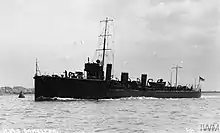HMS Cameleon (1910)
HMS Cameleon was one of 20 Acorn-class destroyers built for the Royal Navy in the 1910s. Completed in 1910, she saw active service in the First World War.
_IWM_SP_839.jpg.webp) Cameleon in Grand Harbour, Malta, 1917 | |
| History | |
|---|---|
| Name | Cameleon |
| Builder | Fairfield Shipbuilding and Engineering Company, Govan |
| Laid down | 6 December 1909 |
| Launched | 2 June 1910 |
| Commissioned | December 1910 |
| Fate | Sold for scrap, 15 November 1921 |
| General characteristics | |
| Class and type | Acorn-class destroyer |
| Displacement | 772 long tons (784 t) |
| Length | 246 ft (75 m) |
| Beam | 25 ft 5 in (7.7 m) |
| Draught | 8 ft 6 in (2.6 m) |
| Installed power |
|
| Propulsion | 3 shafts; 1 steam turbine |
| Speed | 27 knots (50 km/h; 31 mph) |
| Range | 1,540 nmi (2,850 km; 1,770 mi) at 15 knots (28 km/h; 17 mph) |
| Complement | 72 |
| Armament | |
Design and description
The Acorn class marked a return to oil-firing as pioneered in the Tribal or F class of 1905 and HMS Swift of 1907. The Admiralty provided general specifications, but each shipyard did their own detailed design so that ships often varied in size.[1] The Acorns had an overall length of 246 feet (75 m), a beam of 25 feet 5 inches (7.7 m), and a deep draught of 8 feet 6 inches (2.6 m). The ships displaced 772 long tons (784 t) at deep load and their crew numbered 72 officers and ratings.[2]
The destroyers were powered by a single Parsons steam turbine that drove three propeller shafts using steam provided by four Yarrow boilers. The engines developed a total of 13,500 shaft horsepower (10,100 kW) and were designed for a speed of 27 knots (50 km/h; 31 mph). Cameleon reached a speed of 28.2 knots (52.2 km/h; 32.5 mph) from 14,790 shp (11,030 kW) during her sea trials.[3] The Acorns had a range of 1,540 nautical miles (2,850 km; 1,770 mi) at a cruising speed of 15 knots (28 km/h; 17 mph).[2]
The primary armament of the ships consisted of a pair of BL 4-inch (102 mm) MK VIII guns in single, unprotected pivot mounts fore and aft of the superstructure. They were also armed with two single QF 12-pounder (3-inch (76 mm)) guns, one on each broadside between the forward and centre funnels. These destroyers were equipped with a pair of single rotating mounts for 21-inch (533 mm) torpedo tubes amidships and carried two reload torpedoes.[4]
Construction and career

Cameleon was ordered under the 1909–1910 Naval Programme from Fairfield Shipbuilding & Engineering Company. The ship was laid down at the company's Govan shipyard on 6 December 1909, launched on 2 June 1910 and commissioned in December. She was sold for scrap on 21 November 1921.[5]
Citations
- Gardiner & Gray, p. 74
- Friedman, p. 295
- March, p. 109
- Friedman, pp. 119, 295
- Friedman, p. 306
References
- Colledge, J. J.; Warlow, Ben (2006) [1969]. Ships of the Royal Navy: The Complete Record of all Fighting Ships of the Royal Navy (Rev. ed.). London: Chatham Publishing. ISBN 978-1-86176-281-8.
- Friedman, Norman (2009). British Destroyers: From Earliest Days to the Second World War. Barnsley, UK: Seaforth Publishing. ISBN 978-1-84832-049-9.
- Gardiner, Robert & Gray, Randal, eds. (1985). Conway's All The World's Fighting Ships 1906–1921. London: Conway Maritime Press. ISBN 0-85177-245-5.
- March, Edgar J. (1966). British Destroyers: A History of Development, 1892–1953; Drawn by Admiralty Permission From Official Records & Returns, Ships' Covers & Building Plans. London: Seeley Service. OCLC 164893555.